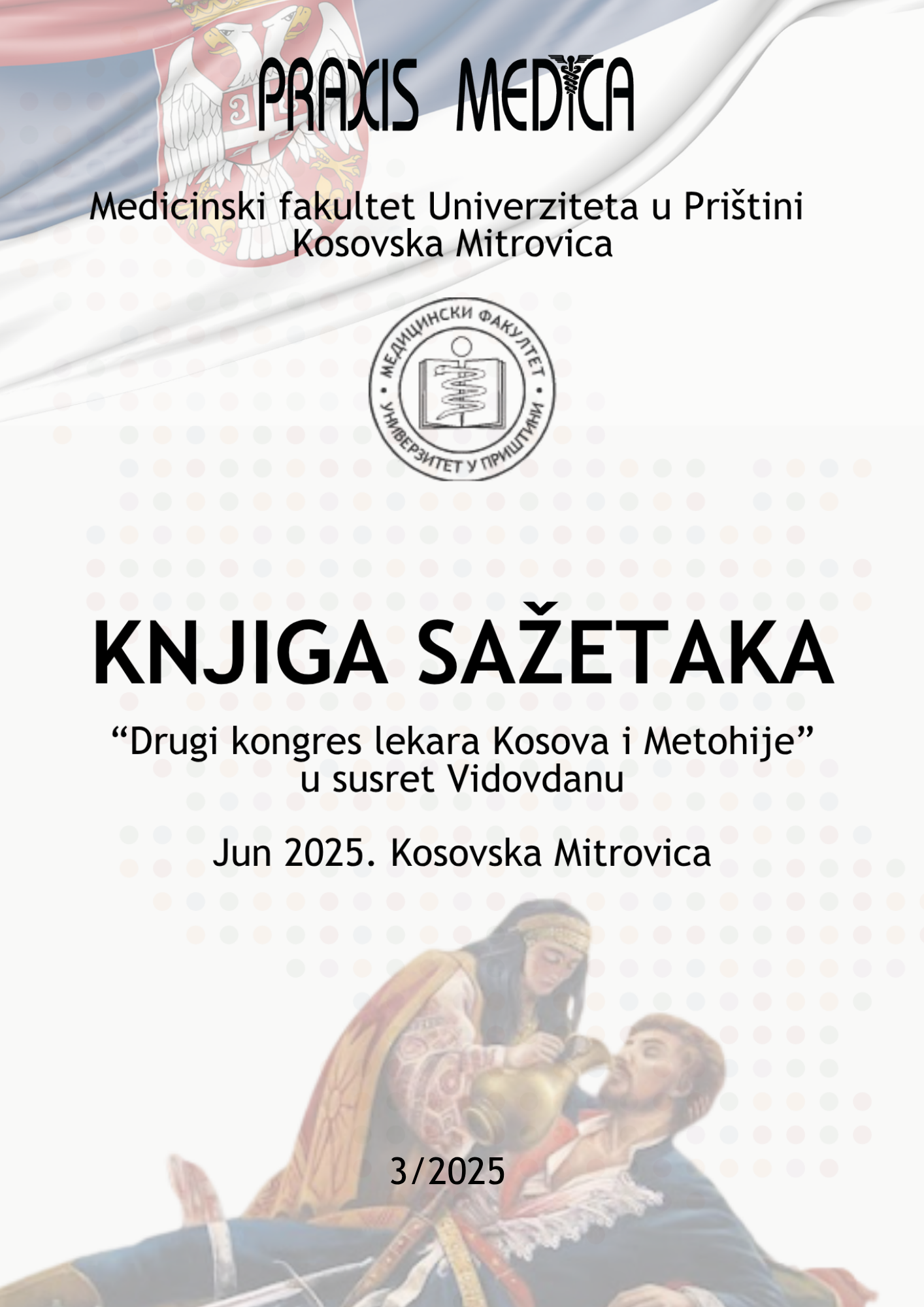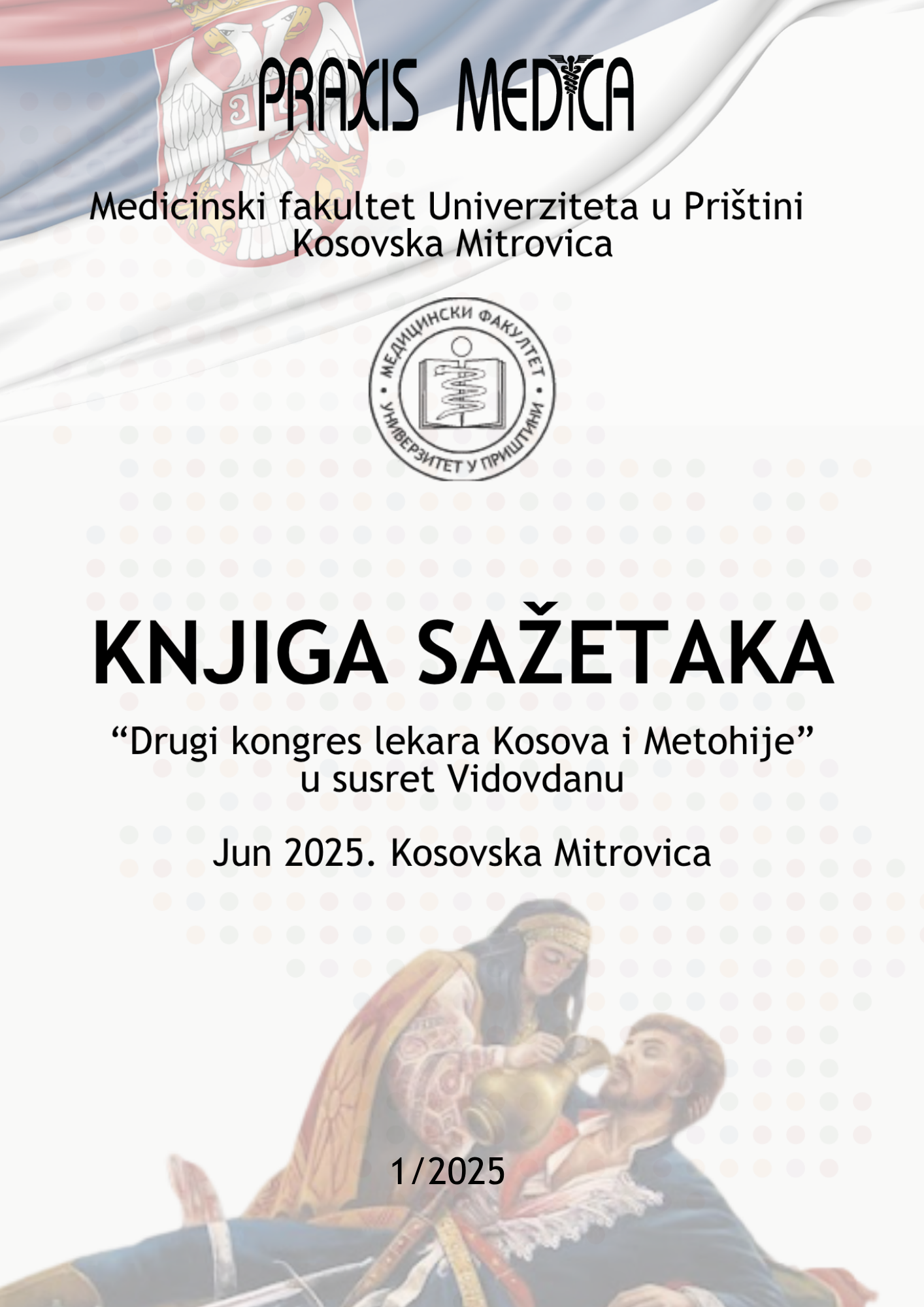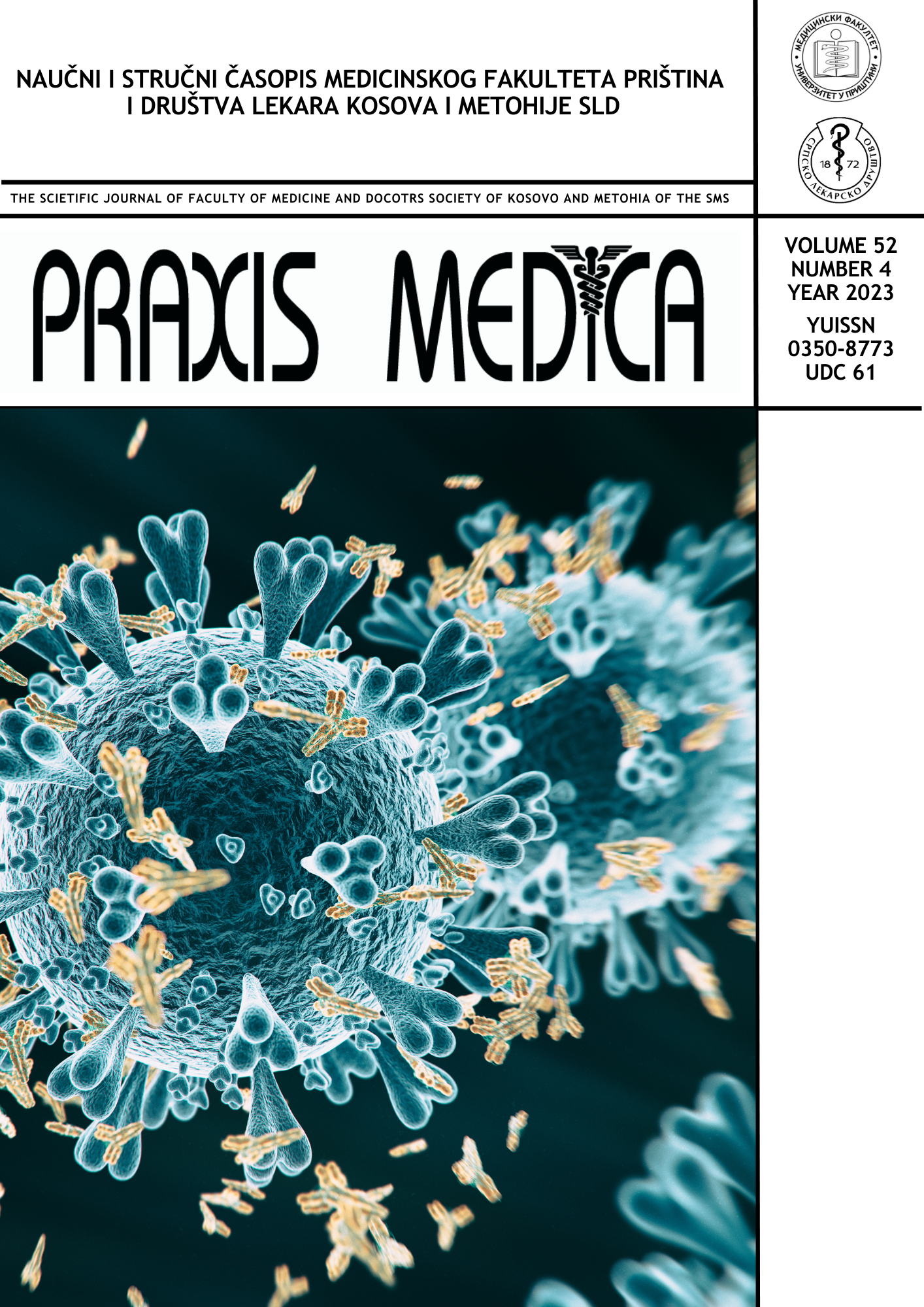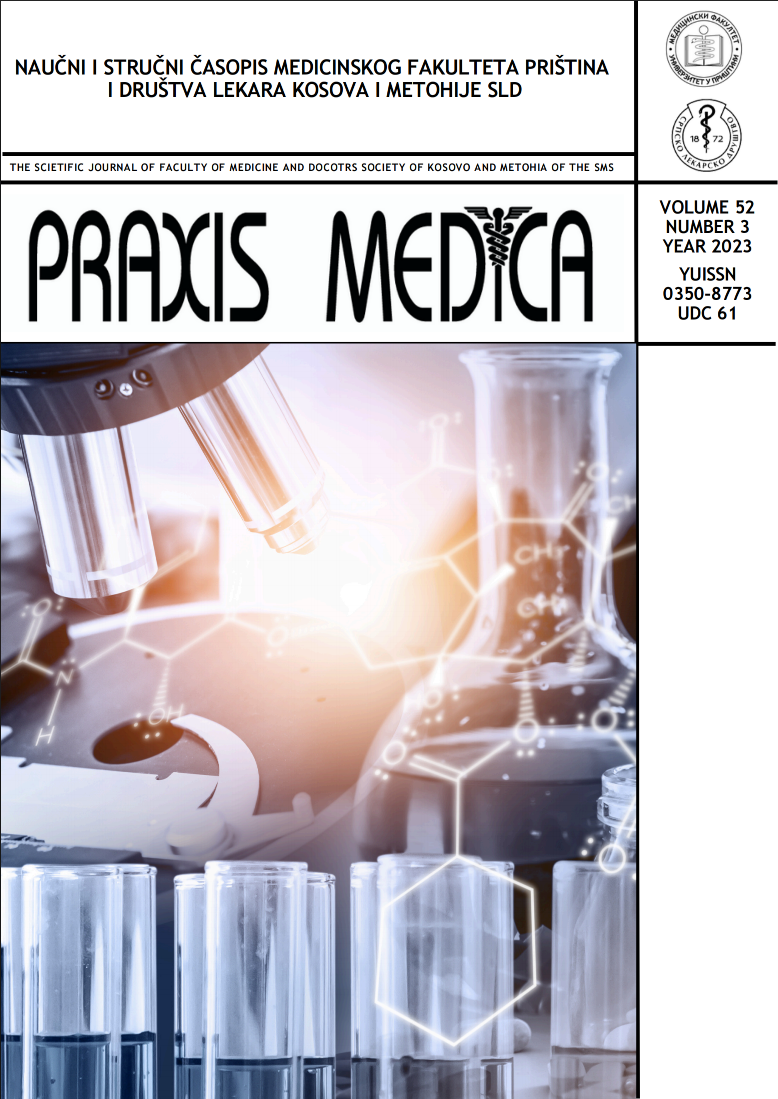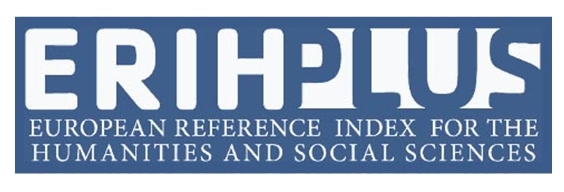Current issue
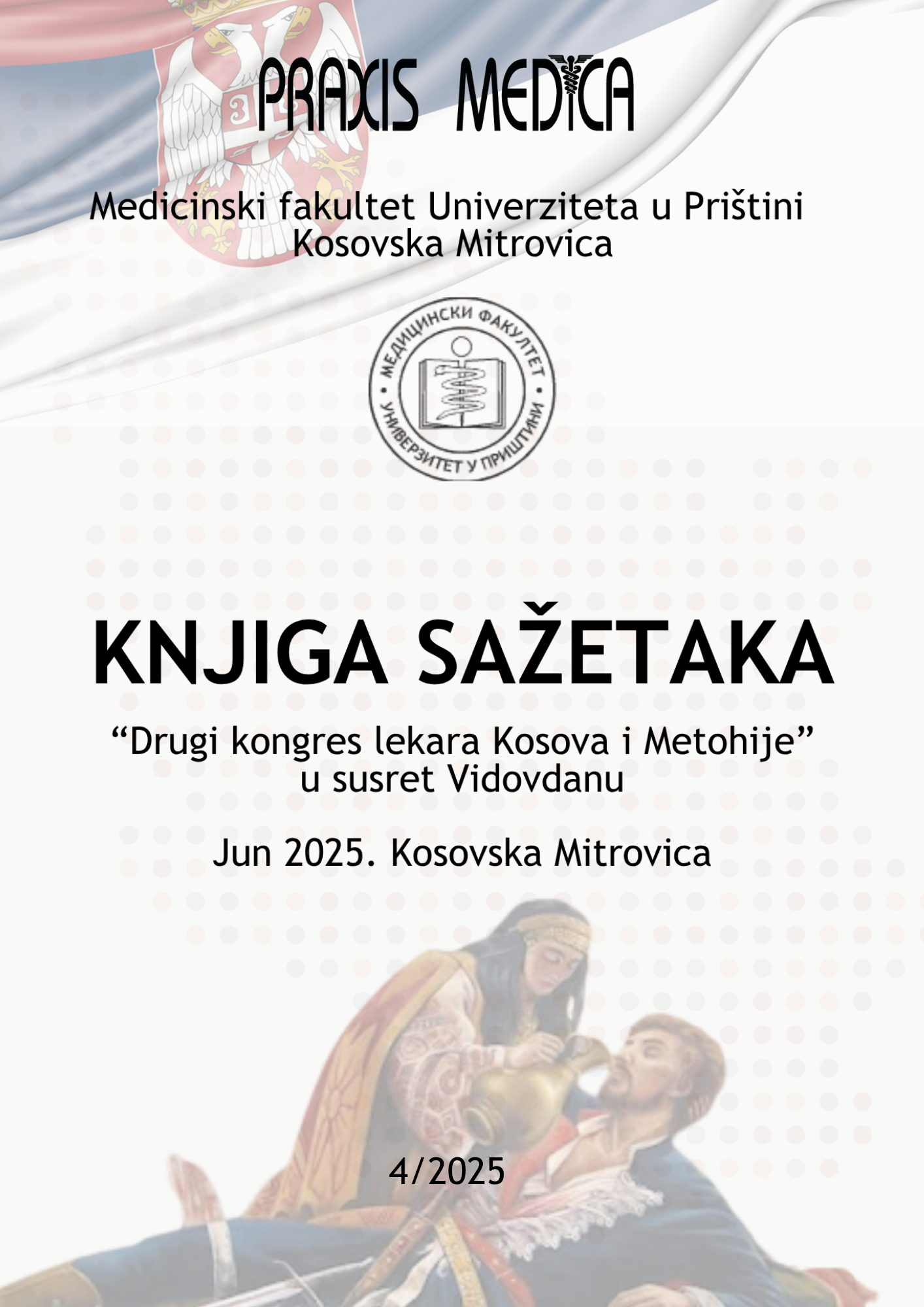
Volume 53, Issue 4, 2025
Online ISSN: 2560-3310
ISSN: 0350-8773
Volume 53 , Issue 4, (2025)
Published: 30.06.2025.
Open Access
All issues
Contents
30.06.2025.
Professional paper
ZDRAVSTVENE KARAKTERISTIKE FLAŠIRANE VODE U MALOPRODAJNIM OBJEKTIMA U KOSOVSKOJ MITROVICI
Uvod: Po pravilniku o kvalitetu i drugim zahtevima za vodu u flaši koja se nalazi u prometu (prirodnu mineralnu, prirodnu izvorsku i stonu vodu), proizvođač je dužan da pre
početka proizvodnje pribavi izveštaje o izvršenom ispitivanju zdravstvene ispravnosti voda (fizičke, hemijske, mikrobiološke
karakteristike, gasni i radiološki sastav) (1) .Ispitivanje zdravstvenih karakteristika flaširane vode je posle najnovijih preporuka Svetske Zdravstvene Organizacije postalo
jedna od vodećih tema u medicini. Potrošači ne biraju vodu po mineralnom sastavu. Zato istraživanja pokazuju da konzumiranje flaširane vode nosi značajne zdravstvene
rizike sa kojima su konzumenti retko upoznati (2). Ipak konzumiranje flaširane vode može doneti i određene benefite po zdravlje.
Cilj: Utvrdjivanje prisutnih vrsta flaširane vode u maloprodajnim objektima u Kosovskoj Mitrovici kao i analiza njihovih zdravstvenih karakteristika.
Metode: Anketom na terenu prikupili smo podatke o flaširanoj vodi iz 15 od ukupno 24 maloprodajnih objekata u Kosovskoj Mitrovici. Vodu smo analizirali prema mineralnom
sastavu.
Rezultati: Najčešće se u maloprodajnim objektima nalaze vode Knjaz Miloš i Aqua viva. Još se u prodaji mogu naći sledeće vode: Rosa, Dea, Voda voda, Suza, Zagori, Vrnjačko
vrelo, Jana, Izvorka, Ana, Radenska, Donat Mg, Pelisterka, Mivela, Vrnjci i Kiseljak. Radenska je voda sa značajnim sadržajem kalcijuma, dok su Mivela i Donat Mg vode sa
značajnom koncentracijom magnezijuma. Voda Vrnjci ima značajnu količinu kalijuma. Takodje, veći broj voda sadrži značajnu količinu natrijuma. Slabomineralne vode Voda
voda Aqua viva sadrže optimalnu količinu fluorida.
Zaključak: Na tržištu je u ponudi paleta najrazličitijih voda u flaši koje sa sobom nose čitav spektar mogućih zdravstvenih rizika ali i zdravstvenih benefita. Neophodno je
upoznati stanovništvo sa velikim značajem koje odabir mineralne vode može imati po njihovo zdravlje.
Ivana Mitrović
30.06.2025.
Professional paper
KOMPLIKACIJE U RADU SA CIRKONIA KERAMIKOM
Uvod: Poslednje dve decenije, cirkonia keramika preuzima primat u izradi fiksnih zubnih nadoknada zbog dobre biokompatibilnosti, dugotrajnosti,
dobrih mehaničkih osobina i povoljnog odnosa cene i kvaliteta. Međutim, u kliničkom radu, cirkonia keramika ispoljava tehničke i biološke
komplikacije.
Glavni deo rada: Zastupljenost i vrsta komplikacija zavise od sva osnovna faktora: tipa cirkonia keramike i indikacije. Osnovni tipovi zirkonia keramike
su monlitna zirkonia keramika (MZK) i fasetirana zirkonia keramika (FZK) koje se značajno razlikuju u pogledu mehaničkih osobina, otpornosti a
poslednično u stopi preživljavanja i uspeha. Dosadašnji rezultati pokazuju drastično višu stopu tehničih komplikacija FZK zbog toga što ona pokazuje
visoku učestalost pucanja i odlamanja fasetirane keramike (chipping). U osnovi problema chipping-a je nedovoljno vezivanje fasetne keramike za
cirkonia keramiku. Ovaj problem se nije uspeo prevazići poboljšanjem tehnološkog procesa izrade već smanjenjem površine koja se fasetira. Sa druge
strane, MZK poseduje izuzetno visoku čvrstoću na savijanje, ali je i kod ove vrste konstrukcija utvđena veća učestalost mehaničkih komplikacija kod
blok konstrukcija u odnosu na pojedinačne krune. Kod implantno retiniranih fiksnih radova od zirkonia keramike pored chipping-a javljaju se i frakture
substrukture i visećeg dela (distalne ekstenzije). Biološke komplikacije kod zirkonia keramike mogu biti rane i kasne. Najčešća rana komplikacija je
lokalizovana gingivalna iritacija, a kasna povećano gingivalno krvarenje na provokaciju.
Zaključak: Monolitna cirkonia keramika, naročito poslednja generacija multi-itria-layered, pokazuje najveći potencijal u smislu tehničkog uspeha i
zadovoljstva pacijenta ali su potrebna dugotrajnija praćenja kliničkih rezultata. Takodje, potrebna su detaljnija ispitivanja o razlozima bioloških
komplikacija na nivou parodontalnih tkiva.
Ključne reči: monolitna cirkonia keramika, fasetirana cirkonia keramika, fraktura, mehaničke komplikacije, biološke komplikacije.
Aleksandra Popovac, Ivica Stančić
30.06.2025.
Professional paper
DIGITALNI PROTOKOL U IZRADI FIKSNIH PROTETSKIH NADOKNADA
Uvod: Digitalna tehnologija je preuzela primat u stomatološkoj praksi I omogućila brže, efikasnije, preciznije I kvalitetnije stomatološke usluge I na
taj način veoma uticala na celokupnu stomatološku profesiju. Osim poboljšanja kvaliteta oralnog zdravlja, povećava produktivnost i ekonomičnost
stomatoloških usluga i pruža bolje iskustvo pacijenatima. Za današnje i buduće studente stomatologije,digitalizovana stomatologija će biti polazna
tačka u učenju i usavršavanju svog znanja.O konvencionalnoj stomatologiji biće reči kao osvrt na prošlost i kako se nekada radilo.
Cilj: Cilj ovog predavanja je ukazati na prednosti kompletno digitalnog postupka izrade fiksnih protetskih nadoknada.
Metodologija: Postupak protetske rehabilitacije obuhvata dobijanje adekvatnih klinickih digitalnih fotografija, njihova upotreba u profesionalnom
programu za dizajn protetskih nadoknada, spektrofotometriju tj. odredjivanje boje susednih zuba, digitalni otisak preparisanih zuba, prenošenje
položaja gornje vilice u digitalni articulator, snimanje pokreta donje vilice, proba privremenih kruna dobijenih 3D stampom i izrada definitivnih
fiksnih nadoknada.
Zaključak: Digitalni protokol u restaurativnoj stomatologiji doveo je do unapredjenja efikasnosti, kvaliteta i predvidivosti protetske terapije.
Ključne reci: Digitalna tehnologija, Digitalni protokol, protetska rehabilitacija
Radivoje Radosavljević, Milan Ćalić
30.06.2025.
Professional paper
МULTIDISCIPLINARNI PRISTUP U DIJAGNOSTICI I TERAPIJI RAZVOJNIH ANOMALIJA ZUBA
Razvojne anomalije zuba predstavljaju kompleksna stanja koja mogu zahvatiti broj, oblik, položaj i strukturu zuba, te često zahtevaju sveobuhvatan
pristup u dijagnostici i terapiji. Zbog složenosti ovih poremećaja, uspešno zbrinjavanje obično prevazilazi okvire jedne stomatološke specijalnosti.
Cilj ovog rada je da, kroz prikaz kliničkih slučajeva, prikaže značaj multidisciplinarnog pristupa u dijagnostici, planiranju i sprovođenju terapije kod
pacijenata sa razvojnim anomalijama zuba. U radu su prikazana tri klinička slučaja koja ilustruju različite tipove anomalija – poremećaje broja, oblika
i strukture. Kod svakog pacijenta sprovedena je detaljna klinička i radiološka dijagnostika, nakon čega je izrađen individualni terapijski plan koji je
uključivao saradnju dečjeg stomatologa, ortodonta i oralnog hirurga. Invazivni postupci, restaurativne terapije i ekstrakcije primenjeni su u
slučajevima težih oblika poremećaja u strukturi i obliku zuba, uz primenu odgovarajuće ortodonske terapije. Poseban akcenat stavljen je na značaj
adekvatne oralne higijene, pravilne ishrane, remineralizacionih postupaka, zalivanja fisura i redovnih kontrola. Tok terapije, redosled intervencija i
postignuti rezultati detaljno su analizirani.
Dobijeni rezultati potvrđuju da multidisciplinarni pristup doprinosi boljoj funkcionalnoj rehabilitaciji, estetskom zadovoljenju pacijenata i dugoročnoj
stabilnosti terapije. Prikazani slučajevi naglašavaju važnost pravovremene dijagnoze, preciznog planiranja i timske saradnje u lečenju kompleksnih
dentalnih anomalija.
Ključne reči: multidisciplinarni pristup, anomalije zuba, dijagnostika, terapija, deca
Brankica Martinović, Amra Daždarević, Marija Velić
30.06.2025.
Professional paper
UPOTREBA DRUŠTVENIH MREŽA I INTERNET PLATFORMI U CILJU UNAPREĐENJA UČENJA STUDENATA MEDICINE
Uvod: U digitalnom dobu, internet platforme i društvene mreže sve više postaju deo obrazovnog procesa. Iako se često tretiraju kao faktori koji odvlače pažnju, njihova
pravilna upotreba može poboljšati razumevanje složenih pojmova.
Cilj: Ispitati u kojoj meri studenti medicine koriste društvene mreže i internet platforme u svrhu učenja, kao i analizirati uticaj edukativnog videa postavljenog na TikTok
platformi na rezultate drugog kolokvijuma iz statistike.
Materijali i metode: Istraživanje je sprovedeno u zimskom semestru 2023. godine, među studentima Medicinskog fakulteta Univerziteta u Prištini. Podatke smo prikupili
anketom i obradili ih deskriptivnim statističkim metodama koristeći SPSS 21. Kao dodatni edukativni materijal, korišćen je kratak video postavljen na društvenu mrežu TikTok,
sa ciljem pojašnjenja oblasti relevantne za drugi kolokvijum iz statistike. Analizirane su navike u učenju, vreme provedeno na mrežama, kao i poznavanje edukativnih kanala
kao što su Ninja Nerd i Osmosis.
Rezultati: Svi ispitanici koriste društvene mreže, pri čemu 48,48% studenata navodi da ih koristi između jedan i tri sata dnevno, a čak 39% više od tri sata. Uprkos visokoj
zastupljenosti u svakodnevici, samo mali broj studenata koristi edukativne internet platforme – 22% prati kanal Ninja Nerd, dok svega 5% prati Osmosis. Svi studenti koji prate
ove kanale izjavili su da im je sadržaj bio od koristi prilikom učenja. Od ukupno 52 studenta, 75% je tačno odgovorilo na oba pitanja, što predstavlja značajan porast u odnosu
na prethodni kolokvijum, na kojem je većina studenata imala jedan ili nijedan tačan odgovor. Samo 7,7% studenata nije dalo nijedan tačan odgovor nakon videa, dok je 17,3%
imalo jedan tačan odgovor.
Zaključak: Iako je korišćenje edukativnih internet sadržaja i dalje ograničeno, studenti koji ih koriste pokazuju bolji uspeh. Potrebno je ohrabriti studente da iskoriste
potencijal mreža u edukativne svrhe, integrišući učenje u njihovu svakodnevicu.
Ključne reči: društvene mreže, studenti medicine, učenje, internet platforme, TikTok
Jelena Cvetković
30.06.2025.
Professional paper
UTICAJ PANDEMIJE COVID-19 NA POTROŠNJU ANTIDIJABETIKA U SRBIJI: JOINPOINT ANALIZA TRENDA
Uvod: Osobe sa dijabetesom češće su imale teže kliničke oblike COVID-19. Međutim, postoji hipoteza da određeni antidijabetički lekovi mogu biti
povezani sa boljim ishodima kod pacijenata sa COVID-19. Cilj ove studije bio je da se analizira da li je pandemija COVID-19 uticala na promenu
potrošnje antidijabetika u Srbiji.
Metode: Ova deskriptivna analiza je sprovedena korišćenjem javno dostupnih podataka dobijenih sa zvaničnog sajta Agencije za lekove i medicinska
sredstva Srbije u periodu 2006-2022. Regresiona analiza jointpoint je primenjena za ispitivanje dinamike korišćenja antidijabetičkih lekova tokom
ispitivanog perioda.
Rezultati: U Republici Srbiji je ova studija analizirala upotrebu 28 antidijabetičkih lekova u periodu od 2006. do 2022. godine. Rezultati su pokazali
da je na početku pandemije COVID-19 došlo do povećanja potrošnje dulaglutida (počev od 2020. godine) i smanjenje potrošnje insulina detemir
(počev od 2019), insulina lispro (kombinovanog) i insulina lispro (brzodelujućeg) (počev od 2020.).
Zaključak: Naša studija je otkrila značajne promene u upotrebi određenih antidijabetičkih lekova, kao što su povećana potrošnja dulaglutida i
smanjena upotreba različitih tipova insulina. Ove promene odražavaju strategije koje se razvijaju u lečenju dijabetesa za bolju podršku pacijentima
tokom ove globalne zdravstvene krize.
Ključne reči: antidijabetički lekovi, uticaj Covid-19, potrošnja, Srbija
Jelena Filimonović, Marija Milić, Zorica Stanojevic Ristić
30.06.2025.
Professional paper
DEPRESIJA, ANKSIOZNOST I STRES U STUDENSTKOJ POPULACIJI
Uvod: Problemi sa mentalnim zdravljem postaju sve zastupljeniji i među studentima. Istraživanja su pokazala da gotovo polovina univerzitetskih studenata pokazuje umerene
nivoe mentalnih problema povezanih sa stresom, uključujući i anksioznost i depresiju.
Cilj rada: Utvrditi prevalenciju anksioznosti, depresije i stresa u studentskoj populaciji.
Materijal i metod rada: Istraživanje je urađeno kao studija preseka. Kao instrument istraživanja korišćena
je skala za procenu depresivnosti, anksioznosti i stresa (DASS-42). Od statističkih metoda korišćeni su hi- kvadrat i Mann–Whitney test, sa nivoom značajnosti od 0,05.
Rezultati: U istraživanju je učestvovalo 600 studenata, od kojih je 34% bilo muškog pola, a 66% ženskog pola. Prosečna starosna dob studenata je iznosila 20.2±1.5 a
studentkinja 19.9±1.4. Analiza skale anksioznosti je pokazala da 6,7% studenata ima blagu anksioznost, 7,3% srednje tešku, dok je 12,8%
imalo ekstremno tešku anksioznost. Skala depresije je pokazala, da je blagi osećaj depresivnosti prisutan kod 5,8% studenata, umereni 4,8%, teški 1,5%, dok je ekstremno
teški osećaj bio prisutan kod 15,8% studenata. Na skali stresa, 10,2% studenata je osetilo blagi stres, umeren stres je bio prisutan kod 6,7%
studenata, dok je jak stres imalo 6.7%. Učestalost povišenog stresa je značajno učestalija kod studenata ženskog pola (hi kvadrat=14.914, p<0.001). Povišen stres je bio
zastupljen kod 33,1% ženskog pola a 18,1% kod muškog pola. Anskioznost je značajno izraženija kod studentkinja u odnosu na studente (hi kvadrat=6,204, p<0.013) a za
depresiju nema značajne razlike između polova. Kada je u pitanju fakultet, studenti sa medicine su imali znatno manje izražene simptome depresije, stresa i anksioznosti u
odnosu na studente sa drugih fakulteta.
Zaključak: Studenti medicine imaju znatno niži stepen depresije, stresa i anksioznosti u odnosu na studente sa drugih fakulteta. Anksioznost i stres je izraženija kod
studentkinja u odnosu na studente.
Ključne reči: Studenti, DASS-42, stres, anksioznost, depresija.
Elma Selimi, Đorđe Ilić
30.06.2025.
Professional paper
PRIMENA KONCEPTA MКPB MODULA ZA SPROVOĐENJE TRANSDISCIPLINARNOG NAUČNOG PRISTUPA U POSLEDIPLOMSKOM MEDICINSKOM OBRAZOVANJU
Postojeći model obrazovanja kadrova u oblasti uticaja životne sredine na zdravlje čoveka, karakteriše izrazita stručna i sektorska fragmentacija. Umesto da integriše sve
pozitivne aspekte multidisciplinarnosti, interdisciplinarnosti i transdisciplinarnosti, trenutni model često favorizuje uskostručne pristupe. Ova fragmentacija je prisutna
između različitih naučnih i stručnih oblasti - biologije, hemije, poljoprivrede, medicine, inženjerskih nauka, ali i ekonomije, prava i društvenih nauka. U takvom okviru,
stručnjaci iz različitih disciplina često pristupaju problemima isključivo iz perspektive svojih struka, boreći se za „svoj deo kolača“, što rezultira uskim i jednostranim
tumačenjima problema. Ovaj pristup neretko stvara nove izvore sukoba među stručnjacima, jer se različite struke međusobno ne prepoznaju kao komplementarne, već kao
konkurentske, što dodatno otežava efikasno rešavanje složenih problema. Takva fragmentacija je posebno problematična kada je reč o pitanjima životne sredine, jer ona
zahteva celovit pristup. Zdravstveni problemi izazvani faktorima iz životne sredine, kao što su zagađenje, klimatske promene, izloženost štetnim materijama ili
nanočesticama, uticaj socijalnog okruženja itd. ne mogu se adekvatno razumeti i rešavati ako se razmatraju parcijalno, iz ugla samo jedne naučne discipline. Životna sredina
je sveobuhvatan sistem, i sveobuhvatni problemi koji iz nje proističu moraju biti tretirani integrisano - uzimajući u obzir sve relevantne aspekte koji mogu doprineti rešavanju
tih problema. Za realizaciju poslediplomskih studija u ovoj oblasti neophodna je transdiciplinarna saradnja između različitih disciplina, ne samo na nivou razmene
informacija, već kroz aktivno povezivanje i preplitanje različitih metodologija i perspektiva kako bi se došlo do inovativnih i održivih rešenja. Obim različitih rizika po životnu
sredinu i zdravlje čoveka, koji nastaju u savremenom društvu, svakog dana je sve veći. Tako se danas kao glavni faktori uticaja na zdravlje ljudi pojavljuju neki rizici koji pre
samo par godina ili desetina godina nisu ni postojali. Iz istih razloga pristup temi rizika po životnu sredinu i zdravlje čoveka postao je problematičan i u razvijenim zemljama.
U nizu kritičnih situacija nastalih u oblasti zaštite životne sredine i zdravlja čoveka, različite države nisu imale adekvatne odgovore na nastale probleme. Kao na primer u
slučajevima sve češćih vanrednih situacija (poplave, akcidenti u industriji i saobraćaju itd.), aerozagađenja, novih rudarskih postrojenja, COVID, neadekvatne bezbednosti
hrane, zavisnosti od interneta, društvenih kriza itd. Jedan od glavnih razloga tome bio je upravo nedostatak odgovarajućih stručnjaka koji bi na pravi način mogli da sagledaju
ove probleme i ukažu stanovništvu i državnim aparatima kako treba ispravno postupati. Analizom navedenih problema ustanovili smo da postoji potreba da se kroz obrazovni
sistem stvore stručnjaci koji će, usvajanjem transdisciplinarnih znanja, na adekvatan način moći da odgovore svim savremenim izazovima u oblasti zaštite životne sredine i
zdravlja stanovništva. Postojeći obrazovni modeli, u okviru poslediplomske edukacije lekara, nisu u stanju da proizvedu takve stručnjake pa je neophodno sprovesti
transformaciju obrazovnog procesa u ovoj oblasti i to direktnom intervencijom u konceptu učenja usvojen primenom MCPB modula, a kroz primenu problem based blended
learning blocks modula sa integrisanim transdisciplinarnim znanjima(TransBlox), a koji će dopunjavati teorijsku i praktičnu nastavu u okviru Blended learning kurseva na
Moodle platformi. U okviru ovih modula, nakon uvodnog teksta u kojem se postavlja problem i istraživački cilj, svaki naredni korak će uključivati vođena pitanja prilagođena
rešavanju postavljenog problema. Ova pitanja će biti interaktivno dizajnirana, s mogućnošću biranja ponuđenih odgovora ili unošenja odgovora u predviđena polja.
Odgovarajući na vođena pitanja, student će postupno identifikovati ključne komponente koje treba razjasniti i, prateći logičan sled pitanja, učiti kako da sistematski rešava
problem. Korišćenje unapređenih modula omogućuje integraciju transdosciplinarnih znanja u nastavne kurikulume poslediplomskih studija i maksimalnu objektivnost u
praćenju nastave i ocenjivanju, kao i transparentnost i demokratičnost celokupnog nastavnog procesa.
Ključne reči: Transdisdiplinarnost, meta-kognicija, poslediplomsko obrazovanje lekara
Aleksandar Ćorac, Zoran Bukumirić
30.06.2025.
Professional paper
JAVNOZDRAVSTVENI ZNAČAJ POVREDA KOD DECE PUTNIKA U VOZILU
Povrede koje deca zadobijaju kao putnici u vozilima predstavljaju značajan javnozdravstveni problem zbog njihove učestalosti, težine posledica i mogućnosti
prevencije. Povreda se definiše kao telesno oštećenje nastalo usled akutnog izlaganja energiji koja prevazilazi fiziološke granice tolerancije organizma. Iako se
često nazivaju „nesrećama“, povrede nisu nasumični događaji; one se dešavaju u predvidivim okolnostima sa prepoznatljivim faktorima rizika. Među nenamernim
povredama, saobraćajne povrede predstavljaju jedan od vodećih uzroka smrti i invaliditeta dece širom sveta. Prema podacima Svetske zdravstvene organizacije,
više od 1,3 miliona ljudi godišnje izgubi život u saobraćajnim nesrećama, pri čemu su deca uzrasta od 2 do 14 godina posebno ugrožena. U Srbiji, gotovo polovina
svih smrtnih slučajeva u saobraćaju u kojima su deca učestvovala, dogodila se dok su bila putnici u vozilu. Većina ovih povreda mogla je biti sprečena ili
značajno ublažena da su bile primenjene odgovarajuće mere bezbednosti—kao što su sigurnosni pojasevi ili dečija sedišta—u skladu sa uzrastom i fizičkim
razvojem deteta. Pravilna upotreba dečijih auto-sedišta može smanjiti rizik od smrtonosne povrede i do 60%. Zdravstveni radnici imaju ključnu ulogu u edukaciji
roditelja o ispravnoj upotrebi sistema za vezivanje i u razbijanju uobičajenih zabluda. Njihov autoritet i čest kontakt sa starateljima čine ih ključnim akterima u
promociji bezbednosti dece u saobraćaju. Haddonova matrica predstavlja konceptualni okvir za analizu faktora rizika i identifikaciju mogućnosti za intervenciju
kroz faze pre događaja, tokom događaja i nakon događaja. Efektivna prevencija zahteva saradnju više sektora, ciljanu javnu edukaciju, unapređeno sprovođenje
zakona i pristup zasnovan na podacima iz javnog zdravlja. Na kraju, smanjenje broja povreda među decom putnicima predstavlja zajedničku društvenu
odgovornost koja zavisi od proaktivne edukacije, sprovođenja politika i strateškog uključivanja zdravstvenog sistema.
Ključne reči: povrede dece, saobraćajne nezgode, javno zdravlje, bezbednost vozila, dečija autosedišta, prevencija povreda, zdravstveno vaspitanje
Mirjana Štrbac
30.06.2025.
Professional paper
POTREBA I ZNAČAJ MOLITVE I LJUBAVI ZA PSIHOFIZIČKI BALANS DETEKTOVANO KVANTNOM DIJAGNOSTIKOM
Savremena medicina sve više daje važnost psiholoških, emotivnih i duhovnih faktora u očuvanju psihofizičkog zdravlja. Čovek, organ, ćelija je svetlosna energija
čestica biofotona koja ima svoju vibraciju - frekvencu koja se može izmeriti različitim uređajima. Jedna od njih je metoda kvantne medicine, koja koristi
različite instrumente koje preko glavnih 12 i sporednih meridijana i akupukturnih tačaka registruju protok energije i očitavaju stanje ćelija, organa i organizma.
Detektuju se energetsko stanje organizma ( aura I čakre); fiziološki I biohemijski parametari, markeri, hormoni, vitamin , minerali, tako i patologija i patogeni (
paraziti, virusi, gljivice, bakterije, protozoe). Suština lečenja kvantnom medicinom krije se u sledećem: ako je materija neuništiva, neuništiva je i informacija
koju ona sadrži. Pri nastanku bolesti, postoji informacija o bolesti, ali je njoj prethodila informacija o zdravom stanju, te se korigovanjem poremećene
frekvencije elektromagnetnog polja organizam može vratiti u elektromagnetnu ravnotežu, ili joj se bar približiti. Kvantna medicina spaja najsavremenija
dostignuća biofizike i kvantne fizike sa poznavanjem energetskih polja u organizmu. Svaka misao, svaka emocija i raspoloženje utiču na biofizičku stabilnost
ćelije. Molitva ( religijska, personalna, meditacija, tetahealing ) povećavaju vibraciju ćelije, aktivira se parasimpatikus, smanjuje se kortisol, upalni procesi.
Pozitivne misli i emocije koje imaju veliku vibraciju kao što su molitva, bezuslovna ljubav,radost, saosećanje, empatija, opraštanje i pokajanje su dubinski
čistači ćelija. Raspon vrednost ovih emocija je od 500 Hz do 1000 Hz, za razliku od nižih emocija: tuga, ljutnja, briga, strah, koje vibriraju nisko ( 0,4 Hz – 20Hz
), te uvode organizam u disbalans. Svesnost čistih misli i emocija visokih vibracija su ogledalo našeg zdravlja. Reče Otac Tadej: “ Kakve su nam misli, takav nam
je život”.
Milica Burazor


